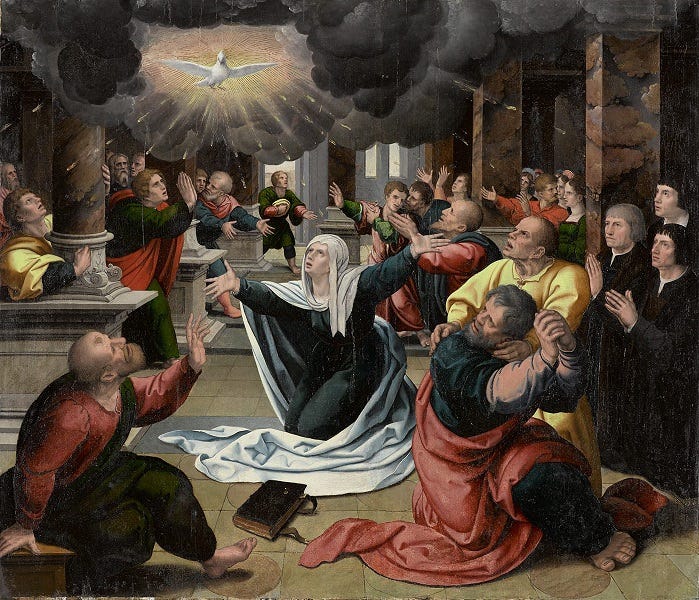If you are asking yourself “who are the 6 Honest Serving Men?” - we’ll get back to that in a few minutes. But for now, let’s just say that they were a big help in writing this message. Today we’re going to dig into Pentecost, the birthday of the Christian Church.
The arrival of the Holy Spirit at Pentecost in the first century unleashed the Holy Spirit and the Christian church upon the world and changed it forever. Short of a true miracle on the scale of what is described in the New Testament book of Acts, there is no other explanation for the explosive growth of the Church that started immediately after Pentecost and continues until the present day. That’s why Christians have been celebrating the event every year since it happened.
This study will explore the people, place and things around the event of Pentecost by seeking to answer some very basic questions.
We know what happened from the countless number of times that the story of Pentecost has been taught in the church throughout the centuries – so we won’t spend a lot of time on that today. But it might help to take a moment to ponder what touched you personally about what transpired that day.
For me, it was the fulfillment of God’s promises. The Holy Spirit just didn’t show up unexpectedly. The believers there were waiting for Him (Acts 1:4-5). They were waiting for not only what Jesus told them to expect soon (Acts 1:8), but also the fulfillment of the promise He made to them all the way back in John 14:26:
“But the Advocate, the Holy Spirit, whom the Father will send in my name, will teach you all things and will remind you of everything I have said to you.”
It’s also important to explore how it all happened. It was most likely a major event. Many early paintings, frescoes and stained glass works of art were created depicting the event, and almost all of them present it as being epic.
It is reasonable to conclude that when the Holy Spirit burst out of heaven, it “drew a crowd,” as we would say today. This “Divine Wind” may have hit Jerusalem like a hurricane that dropped straight out of heaven but didn’t move a thing on earth except the hearts of the Disciples and many of those who were witnesses.
The Bible explains why the Holy Spirit came to earth at Pentecost, as in John 14:26 above, and in some of Paul’s epistles like Ephesians 1:13-14. But writings of the early church fathers also tell us why. After years of devoted study, in the late second century Irenaeus wrote this:
"For the Lord promised to send the Comforter, who should join us to God. For as a compacted lump of dough cannot be formed of dry wheat without moisture, nor can a loaf possess unity, so, in like manner, neither could we, being many, be made one in Christ Jesus without the water from heaven." (Against Heresies, Book III, Chapter 17, Section 1)
The writings of others around that time in church history like Justin Martyr in his First Apology and Tertullian in his writing Against Praxeas, reflect on the role of the Holy Spirit, drawing from the events at Pentecost to explain their theological significance. Why are the writings of these early saints and other great church leaders through the ages important for a modern-day Christian to know about? Great question!
Answer: These men were contending over the truth of the Bible against pagan traditions, heresies and secular philosophers who made false claims about the teachings of Jesus in an effort to twist them to suit their own beliefs or discount them entirely. The writings of the early saints and great teachers preserved the Gospel and helped shape the church as we know it today.
Which brings us to the next way we should briefly dig into the story: Who was there when the Holy Spirit came down from heaven? The Bible tells us a lot in Acts about the people in that upper room, but other verses in the book of Acts, and records of ancient Christian teachings, give us additional information. In Acts 1:13-15 we see the following names – and the number:
When they arrived, they went upstairs to the room where they were staying. Those present were Peter, John, James and Andrew; Philip and Thomas, Bartholomew and Matthew; James son of Alphaeus and Simon the Zealot, and Judas son of James. They all joined together constantly in prayer, along with the women and Mary the mother of Jesus, and with his brothers. In those days Peter stood up among the believers (a group numbering about a hundred and twenty)…
Luke didn’t name everyone there, but one of the great women of the New Testament was almost surely with them – Mary the mother of John Mark. Perhaps she wasn’t named simply because Luke figured that by the time he wrote his second book of the New Testament, everyone would have assumed that she was there, simply because the upper room was in her house.
So, how do we know that? The answer to that question brings us to the last Pentecost topic we will excavate today: Where did it happen, and more specifically, where was that upper room?
Acts 12:12 says that Peter went to the house of Mary, the mother of John Mark, after his miraculous escape from prison. Her house is noted in that text as a gathering place for early Christians, suggesting that she was a major supporter of the early church in Jerusalem. In addition, a host of early church fathers from the first and second century established that the “Upper Room” that was referred to in several places in the New Testament, was located in Mary’s house.
In fact, traditional association of the “Upper Room” with Mary the mother of Mark was so firmly established that by the mid-fourth century AD, the site was a pilgrimage destination for Christians from all over the world.
The traditional location of Mary’s house today is known as The Cenacle on Mount Zion. Mary’s upper room is believed by most scholars and theologians to be where many of the “Upper Room” events in the New Testament took place, including the Last Supper and Pentecost.
This tradition was first documented by Helena, Roman Emperor Constantine's mother, when she went on a faith pilgrimage to Jerusalem around 326-328 AD and found a large number of Christians who had traveled great distances worshiping there. Saint Helena was another great woman of faith in Christian history.
In the past, you may have heard a preacher or Bible teacher mention that the upper room was in Mary’s house. Now you know why that tradition is taught when relating Bible stories in some denominations of the church.
While it’s very unlikely that the Cenacle that exists today is the actual house Mary owned, historical and archeological records show that her house was very much like it, a large multi-story house with many rooms. This house would have been owned by one of the wealthier families of first century Jerusalem.
What we learn from Christian traditions like that one is a part of the complete body of knowledge in the church today. Traditions connect Holy scripture with strong oral traditions and writings from the earliest days of the Church. So, I should be very clear about this.
Facts found in traditions of the church that are not found in the Bible should not be thought of as information that is equal to or even similar to the inspired word of God in scripture. Our faith must remain anchored in “Sola Scriptura.” Even so, Christian traditions are a time-honored tool to help us experience and understand the Bible more fully.
By now you may have forgotten about the “6 Honest Serving Men,” but I did promise that we would get back to it. If you don’t remember it from High School, it’s an interesting story. And it offers a great way to study the Bible.
Several years ago, when I began the faith journey that has now become Christian Soldier 21, I started with seminary level Bible study classes. I was surprised to discover how methods for studying the Bible were very similar to some things I had learned years ago, first in classes about writing and then more extensively in courses about process management. The phrase “6 Honest Serving Men” is from the beginning of a poem about the art of writing from Rudyard Kipling:
I keep six honest serving men.
(They taught me all I knew);
Their names are What and Why and When,
And How And Where and Who.
Kipling’s poem is often quoted in basic writing studies. In the very different world of consulting and project management, the same concept is called the 5W1H method. It’s a way of understanding a complex project before setting up lean process management systems.
That’s why I said that those guys were a big help in writing this article. I use Kipling’s 6 Honest Serving Men when I start digging into the Bible and the writings of church fathers for answers to today’s tough questions. It’s not always easy, but it always works – even for topics in the headlines today that seem far removed from anything that has to do with God or the Bible.
That’s another reason why the Holy Spirit came to us at Pentecost, to help every Christian since that day embrace all the answers that are waiting in God’s Word, answers that are still waiting there for us 21 centuries later.
The Spirit will help you dig, all you need is the basic faith of belief in our Lord. That basic faith is our shovel. Seeking better ways to use that shovel invites the Holy Spirit to help us find the mature faith of a Christian Soldier.
Email your comments or suggestions to: mail@christiansoldier21.org
Note: An earlier version of this post was published on May 17, 2024.







Just out of curiosity ( and i don't intend to debate the subject) but do you believe in "tongues" for today? Or "prophecy"? Or any of what might be called "supernatural" gifts?
Thanks brother - what's important moreso now than ever is for more of Abba Yah's "Church" to wake up and identify with the House of Israel - we are #SpiritualIsrael - GBY